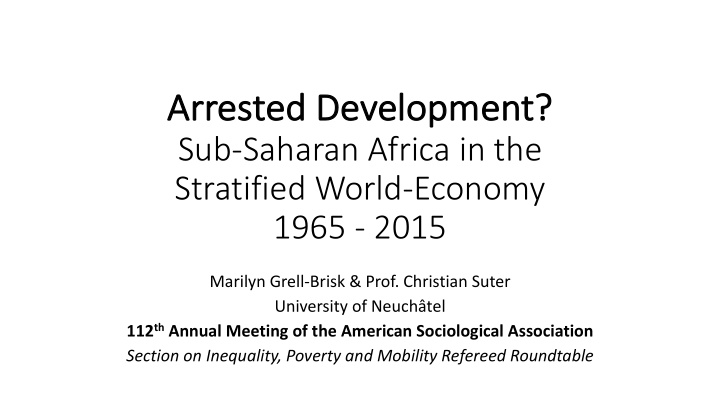



Arrested Development? ? Sub-Saharan Africa in the Stratified World-Economy 1965 - 2015 Marilyn Grell-Brisk & Prof. Christian Suter University of Neuchâtel 112 th Annual Meeting of the American Sociological Association Section on Inequality, Poverty and Mobility Refereed Roundtable
In Introductio ion Ø Macro-comparative approach Wallerstein, I. 1974. The Modern World System Ø Extreme case comparisons Seawright & Gerring. 2008. Case Selection Techniques in Case Study Research
Da Data and Me Meth thod od Ø A question of approach • Wallerstein conceptualization of semi-periphery • structural inequality • how do you measure global economic stratification?
Da Data and Me Meth thod od Ø Arrighi and Drangel • Percent of world population as a function of log GNI per capita • Period of study: 1965 to 2015 • Time not geographic space held constant
Ca Categori orizati tion on of of zon ones 15% peripheral core semiperipheral Percentage of Total World economic zone economic zone economic zone 10% Population 5% 0% 1 2 3 4 5 6 2015 Log GNI Per Capita
Re Results Ø Position of populous countries Ø Position of SSA over time
Re Results Distribution of world population and countries in the global economic hierarchy 1991
Re Results 1991 global economic hierarchy Red: core Yellow: semiperiphery Green: periphery
Re Results Distribution of world population and countries in the global economic hierarchy 2001
Re Results 2001 global economic hierarchy Red: core Yellow: semiperiphery Green: periphery
Re Results Distribution of world population and countries in the global economic hierarchy 2010
Re Results 2010 global economic hierarchy Red: core Yellow: semiperiphery Green: periphery
Re Results Ø Post-decolonization 1965 • SSA countries in semiperiphery included South Africa Gabon Seychelles Zimbabwe Zambia • Remaining SSA countries in periphery
Re Results Percent of SSA in the periphery and semiperiphery from 1965 through 2015.
Re Results Position of Sub-Saharan African countries in the periphery 1985, 1995, 2005, 2015.
Re Results Ø SSA countries • enter at the semiperipheral zone and stay there • move from bottom of distribution to semiperipheral zone and stay there • move up steadily in hierarchy during period of significant Chinese economic intervention
Re Results at the country level
Co Coun untry in F y in Focus cus Zimbabwe Ø Impact of Structural Adjustment Programs (SAPs)? Ø Strengthening civil society? Ø Uneven development and inherently unbalanced economy/‘enclave and dual economy’?
Co Coun untry in F y in Focus cus Zimbabwe Ø Post-independence economic landscape Ø Illusory dynamic economic growth Ø IMF declares “under-borrower” Ø Exogenous stress factors Ø Extreme debt Ø Land reforms
Coun Co untry in F y in Focus cus Botswana Ø Quintessential example of democratic economic development Ø What does luck have to do with it? Ø Homogeneity?
Co Coun untry in F y in Focus cus Botswana Ø Institutional reasons for development Ø Exogenous factors Ø Within country inequality
Arr Arres ested ed devel elop opmen ent? t? SSA in the stratified world-economic system Ø Decreasing between country inequality and possibility for SSA Ø Dutch disease? Ø Geopolitics ?
Th Thank You
Recommend
More recommend